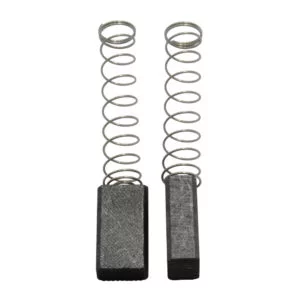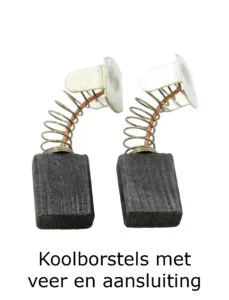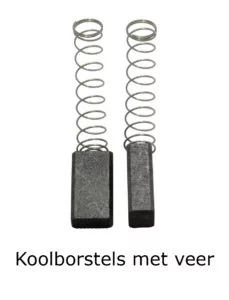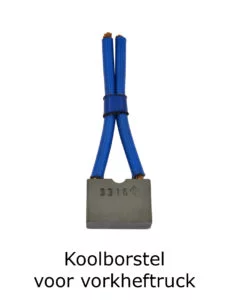What are Carbon Brushes?
A carbon brush is the “object” that conducts electricity to the motor through the motor’s commutator. They transmit electricity to the armature of the motor. Then the anchor will turn, so that the washing drum, drill, kitchen machine will also rotate (via the drive belt).
Carbon brushes are made to wear. If they don’t wear out, and they constantly rub hard against the commutator, it would damage the commutator. So carbon brushes are made of material that is softer than the commutator. After wear and tear, they end up being just tiny nodules. In that case, they must be replaced, as they no longer conduct electricity to the commutator.
If the motor stops spinning, or the appliance stops spinning, sucking, blending or mixing… it’s probably worn carbon brushes.
Not all motors have carbon brushes that you can replace, but most do. Carbon brushes are essential for the proper functioning of brushed electric motors, such as in hammer drills, planes, hedge trimmers, grinders. They are also used in household appliances such as washing machines, hair dryers and shavers. With brush holder, spring, connection or just carbon. Carbon brushes differ based on the make and model number of the machine, but also on the basis of the following characteristics:
- Dimensions
- Brush type
- Image
Wat zijn koolborstels van een motor?
Carbon brushes are part of an electric motor on portable tools such as drills, grinders, planers, trimmers, circular saws or screwdrivers. But they can also be found in vacuum cleaners, washing machines, shavers, hair dryers, espresso machines or forklift trucks.

Carbon brushes allow the passage of electricity to the rotor (the rotating part), and are installed on the fixed part of a motor. They ensure spark-free switching. Depending on the engine, the graphite has a composition with a certain percentage of carbon and/or copper. Because the graphite is softer than the commutator, it wears less and the rotating part has a longer life.
A carbon brush is therefore made in such a way that it is easy to replace. The brushes work in pairs and wear out because they are subject to friction. The carbon brushes are in permanent contact with the collector or slip rings.
WHAT DO CARBON BRUSHES CONTAIN?
Carbon brushes consist of graphite and come in different types. They can be equipped with a connection with a spring or bare (only the brush, without holder or connection).
The carbon brushes come in different sizes and shapes. Mainly square or rectangular, but sometimes they are round and sometimes have grooves for guidance in the machine.
DIFFERENCE BETWEEN A ‘BRUSHED’ ENGINE AND A ‘BRUSHLESS’ ENGINE
Not all electric motors have carbon brushes. Nowadays there are also carbon brushless or ‘brushless’ motors. The advantage of a brushless motor is that it requires almost no maintenance. However, these are more expensive to purchase. The advantage of a brushed motor is that they are often cheaper to purchase, more compact in size and can generate more power.
THE DIFFERENT FEATURES
There are almost as many carbon brushes as there are motors. For this reason and to choose the right carbon brushes for your power tool, several parameters must be considered:
- the measurements
- the type of connection
- the quality of the graphite and the voltage
The dimensions of the carbon brushes
Dimensions are shown in width, depth and length and are expressed in millimeters (mm).
The type of connections
The quality of the graphite and the voltage
The speed, supply voltage, current, etc. affect the quality of the graphite. A wrong choice will result in a lot of sparks or even overheating of the engine. For example, the quality of the graphite in the carbon brush of a forklift truck is different from the carbon brush of a hair dryer.


















